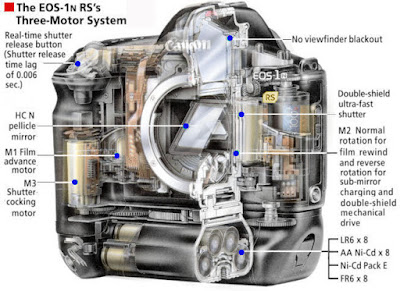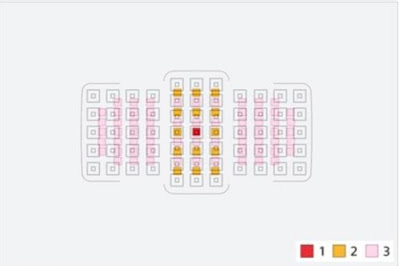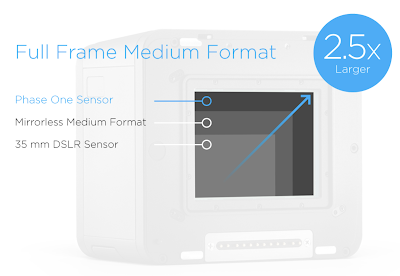PREDICTION: Canon Will Reintroduce the Pellicle Mirror to their DSLR System
The last pellicle mirror camera released by Canon was the EOS-1N RS introduced in 1995 and only discontinued in 2001:
The key prediction being made here today is that the pellicle mirror will return to a 1D equivalent camera some time in the next 4-8 years. Nikon, in the more distant past, has also had pellicle mirror film cameras like the Nikon F2H from 1976, and they too will introduce a pellicle mirror digital single-lens translucent mirror (DSLT) camera with an electronic viewfinder (EVF) replacing an optical viewfinder. Canon tends to be more conservative than Nikon but in this instance Canon appears to own recent patents relevant to pellicle mirror cameras, whereas no DSLT relevant Nikon patents have been discovered. Canon patents relevant to DSLT designs have even been found from more recent years suggesting they remain more active in researching this design concept than Nikon.
The reasons why Canon will introduce a pellicle mirror to their DSLR line to produce an SLT (single lens translucent) camera are as follows.
1. Removal of a Residual Mechanical Moving Component
As frame rates become faster, it becomes more important to eliminate mirror slap as a source of vibrations whose shock can degrade image quality. It will become increasingly difficult to push the maximum frame rate that a mirror moves up and down inside a DSLR camera. The Canon 1DX Mark II already manages to move at a rate of 12fps but it has to be asked how much faster the mirror can be made to move. At a certain point it becomes logical and necessary to replace this moving mechanical component with a pellicle mirror. That would then leave the mechanical shutter as the last outstanding mechanical key component of a DSLR/DSLT camera, and this too will be eliminated with the introduction of global shutters. The question is not if such changes will occur but of when.2. Canon (and Nikon) Cannot Afford to Abandon Their Serious DSLR Users
Canon and their users have too much invested in their DSLR systems in terms of user ownership of lenses and corporate investiture in decades of optical engineering design patents. Some may point to the example of Sony's abandonment of the A mount system as a precedent for Canon to follow, but unlike Sony, Canon (and Nikon) have too much technology invested in their DSLR systems to just abandon the system like this, in expectation of forcing users to switch to mirrorless EVF cameras. Canon has no choice but to technologically advance DSLR design to the next level by the replacement of the optical viewfinder with an EVF and the reintroduction of the pellicle mirror to turn their DSLR systems into superfast action cameras. Those who aren't devoted to shooting fast action will be better served by a mirrorless camera, which should be called AF-sensorless cameras, as they have had the second dedicated phase-detection autofocus (PDAF) sensor amputated to make them smaller. Most users (casual, street, studio and landscape) would be best served by a mirrorless EVF camera, leaving DSLT EVF camera designs for speciality use in shooting action. The age of dominance by DSLR systems may be over but this doesn't mean that DSLT systems cannot retain a specialist niche in the new evolutionary order.3. Pellicle Mirror SLT EVF Cameras Have Advantages Over Mirrorless EVF Cameras
The advantage is the promise of turbo-charged blazing fast autofocus. SLR/SLT cameras have a whole extra dedicated off-imaging focus plane PDAF sensor. This is what makes SLR/SLT cameras autofocus faster when shooting action and in difficult situations eg fast action in low light. Mirrorless cameras aren't just missing a mirror, they are missing an entire dedicated off-imaging focal plane PDAF sensor. The implicit assumption is that cameras can be made to autofocus despite the amputation of the dedicated PDAF sensor by relying solely upon on-imaging sensor AF point under the assumption that the additional off-imaging focus plane AF sensor of SLR/SLT cameras can be safely done away with. While it may be true that adding in that extra autofocus sensor makes the camera bigger but it does balance better against large telephoto lenses. Those who need to gain every advantage in autofocus speed and accuracy under difficult conditions may feel that the trade off in increased camera body size is worth it to get the shot. A niche group of photographers shooting fast action may not want to have their dedicated off-imaging plane PDAF sensor amputated just to make the camera smaller.4. On- and Off-Imaging Sensor AF Are Complementary
The dedicated off-focal plane PDAF sensor confers extra advantages over and above the on-imaging sensor AF (with PDAF points added directly onto the imaging sensor). On- and off-sensor AF are complementary, not mutually exclusive, and can be made to aid one another. The dedicated off-imaging sensor PDAF (off the focal plane of the imaging sensor) turbo boosts the AF making it much faster. The on-imaging sensor AF is more accurate because a discrepancy can creep in between the focal plane of the dedicated off-imaging sensor plane and that of the imaging sensor (this is what produces a need to calibrate the AF on DSLR cameras). PDAF on the imaging sensor (on-focal plane) can be used as a secondary confirm step, as well as to allow AF point selection outside that of the narrower field of coverage from the off-imaging sensor PDAF points. This will take whatever advances in AF from mirrorless cameras make to be added to an SLT camera while the addition dedicated AF sensor effectively turbo boosts AF speed a step beyond that. Advances in off-focal plane dedicated sensor design will only boost the efficiency of SLT AF even further beyond what a mirrorless can offer. Superior AF makes SLT cameras ideal action cameras for field use as a result of the extra dedicated PDAF sensor on top of the imaging sensor turbo boosting the AF system beyond what a mirrorless camera can achieve. If it makes the difference between getting the shot and missing it, this can make all the difference.5. Taking the Load Off the Imaging Sensor May Reduce Noise
The more the imaging sensor has to work as an AF sensor in addition to its job of recording the image, the more image degrading noise it generates. Having a second sensor whose task is just to autofocus may help reduce imaging sensor noise. The downside is that the pellicle mirror itself reduces light transmission, but proliferating AF points on the imaging sensor also degrades imaging quality, so there is an element of give and take here. Ricoh and Canon have patents for reducing the image degradation from the pellicle mirror, so advances in pellicle mirror design remain possible. Sony SLT designs currently block about 1/3 stop of light from being transmitted to the imaging sensor, but this might be able to be improved upon in the future.6. PDAF Only Autofocus Confers Advantages to Lens Design
If Canon use DPAF (dual pixel autofocus) on the imaging sensor and integrate it with the PDAF from a special off-imaging plane PDAF sensor dedicated exclusively to autofocus, then you have a complete PDAF based hybrid AF system. That means that the lens doesn't have to be designed to wobble as it hunts rapidly back and forth to find focus using contrast-detection autofocus (CDAF). The need for the moving lens element to wobble rapidly imposes compromises on image quality in mirrorless systems that use combined PDAF/CDAF systems (not the case with Canon thanks to dual pixel autofocus, DPAF).7. Canon and Nikon Can Improve on Sony's Implementation of the DSLT Design
Sony cameras usually have one spectacular virtue offset by at least one equally spectacular implementation flaw. The lack of adoption by the market of Sony's DSLT design is simply due to implementation flaws in rushing a beta product to market. Canon and Nikon tend to ensure their products are much more mature designs before taking them to market. Canon will not only eliminate viewfinder blackout, but implement a superior off-imaging plane PDAF sensor design, a better pellicle mirror, a superior continuous AF algorithm, and ensure there is no perceptible viewfinder lag before they take their version to market. DSLT pellicle mirror designs are fast action cameras and the product must work seamlessly to a professional sports and wildlife photographer's standards. Canon and Nikon cannot afford to repeat Sony's mistake of throwing beta products onto the market hoping to hit the target. |
| Dedicated PDAF sensor points on the Canon 5DIV. |
 |
| The PDAF points on the Canon 5DIV |
The Design of Electronic Viewfinders Must First Improve
There is one big issue that will slow the inevitable transition to pellicle mirror EVF designs and that is the need to eliminate perceptible EVF lag. At the moment, the optical viewfinder on DSLR cameras is much superior to an EVF (electronic viewfinder). Professional sports photographers notice this even if most amateurs or studio photographers don't. Until EVF designs improve to the point that they can compete professionally with optical finders, Canon and Nikon will delay implementation of the EVF into their DSLR lines. It will probably take another 4-8 years (if not longer) of EVF technology development before EVFs with no perceptible lag come into production. The figure of 4-8 years represents approximately another one to two product cycles of the Canon EOS-1D lineage of cameras. In the meantime, Canon and Nikon are busy developing and marketing their new mirrorless systems, as this must take priority for them to avoid haemorrhaging further market share to Sony in the mirrorless market segment. However, Canon and Nikon should know that they cannot afford to be seen to be abandoning their DSLR systems, which have to be technologically refreshed to retain their attractiveness moving in the future, if they are not to be seen as having been relegated to redundancy like film cameras. The growth of the popularity of mirrorless cameras makes it clear that DSLT cameras will no longer be the mainstream consumer product DSLRs have been for decades, but there remains a place for them as speciality fast action cameras.
Conclusion: The DSLRs is Dead—Long Live the DSLT
Dave Etchells: [M]irrorless makers like Sony say "DSLRs are obsolete. They're gone; they're history". Canon and Nikon say "Well, they each have their role, and some are good for this, and some are good for that". But what do you think about the direction we're really going in, and where we will end up?
Kazuto Yamaki [Sigma CEO]: I agree with Canon and Nikon. There are pros and cons, but eventually, I think the majority of interchangeable-lens cameras will be mirrorless. Probably 80% will be mirrorless?
Interview with Imaging Resource at CP+ in April, 2019
Once again, I agree with Kazuto Yamaki. The majority of interchangeable lens cameras will be mirrorless-EVF cameras, but there is a niche role for pellicle mirror type DSLT-EVF cameras as super fast action photography cameras with their autofocus turbo-charged by a whole extra supplementary off-imaging plane PDAF sensor. This is why I am writing my predictions down now for posterity, so I can say in years to come that "I told you so, I've been saying it for years, but nobody listened to me". If one makes a fool of oneself, good: it's always better to make a bold prediction based on solid reasoning and be confidently wrong, than to be a coward who is never wrong for never sticking one's neck out in making a prediction in the first place.
EDIT: update https://photonicshunkan.blogspot.com/2019/05/the-canon-1dx-ii-successor-will-be.html








Comments
Post a Comment